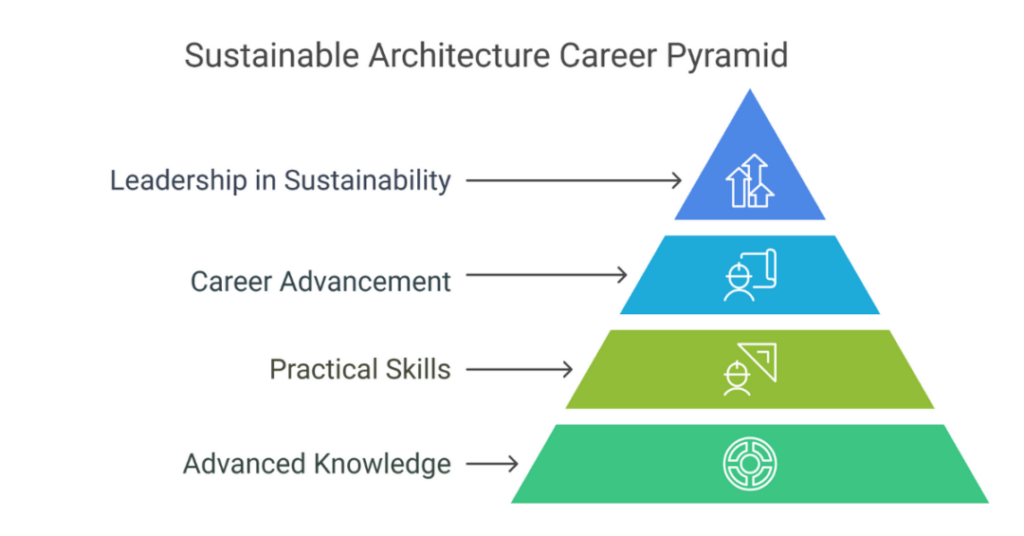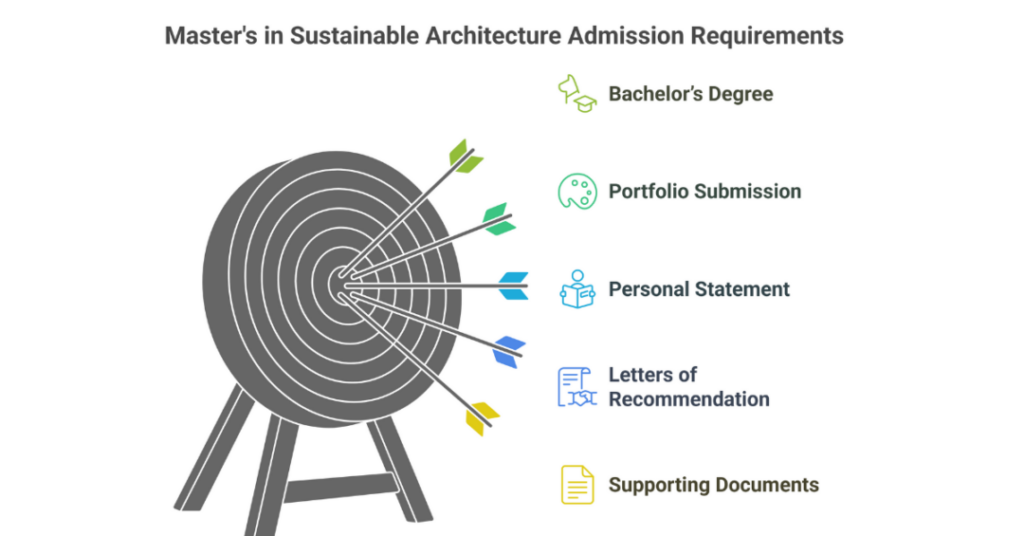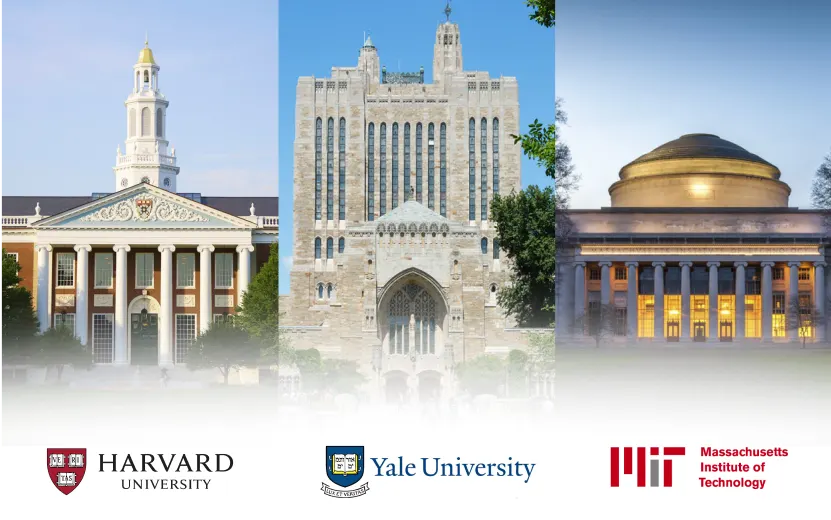28 May 2025
5 minutes read
Masters in Sustainable Architecture in USA for Indian Students

Key Takeaways
- Masters in sustainable architecture in USA equips students with green design skills and prepares them for eco-conscious urban development.
- Masters in sustainable architecture in USA offers cutting-edge curricula blending technology, environmental science, and sustainable building practices.
- Masters in sustainable architecture in USA provides access to top universities, industry internships, and a thriving green job market.
In the evolving world of architecture, “sustainable” is not just a buzzword; it’s a necessity. With the growing awareness of environmental issues, the field of architecture is witnessing a paradigm shift towards sustainability.
Sustainable architecture focuses on designing structures that are environmentally friendly, energy-efficient, and conducive to human well-being.
This approach not only addresses the current environmental challenges but also paves the way for a more sustainable future and urbanism.
As we step into 2025, students must understand and integrate sustainable and environment friendly design principles.
The Importance of a Master’s and Graduate Program in Sustainable Architecture
Pursuing a Master of Science in Sustainable Architecture signifies more than just academic achievement; it represents a commitment to sustainable development and a desire to create a positive impact on the built environment.
- Advanced Knowledge: Provides in-depth knowledge of sustainable design principles, environmental systems, and green building technologies.
- Practical Skills: Develops practical skills in sustainable architecture, including the use of relevant software tools and methodologies.
- Career Advancement: Opens doors to advanced career opportunities in architecture, urban planning, and sustainability consultancy.
- Specialization: Allows for specialization in areas like green building, renewable energy, and urban sustainability, catering to specific career paths.
- Leadership in Sustainability: Equips graduates to become leaders in the field of sustainable design, influencing the future of environmentally responsible architecture.
- Networking Opportunities: Offers access to professional networks, industry connections, and potential mentors in the field of sustainable architecture.
- Research Opportunities: Provides opportunities to engage in cutting-edge research, contributing to the advancement of sustainable design practices.
- Global Perspective: Fosters a global understanding of sustainability challenges and solutions in architecture, preparing students for work in diverse settings.
- Commitment to Sustainability: Demonstrates a personal and professional commitment to promoting sustainable practices in the built environment.
- Increased Competitiveness: Enhances the competitiveness of graduates in the job market, particularly in firms and organizations prioritizing sustainability.
Top Schools Offering Master of Science in Sustainable Architecture in the USA
The USA is home to some of the world’s most prestigious schools of architecture, each offering unique graduate programs in sustainable architecture.
| University Name | Location | Program Highlights | Unique Features | Annual Fees |
|---|---|---|---|---|
| Massachusetts Institute of Technology (MIT) | Cambridge, MA | Emphasis on innovative technology and sustainable urban design | Cutting-edge research facilities, strong industry connections | $53,450 |
| University of California, Berkeley | Berkeley, CA | Focus on environmental science and renewable energy integration | Diverse student body, access to leading sustainability experts | $40,972 |
| Harvard University | Cambridge, MA | Interdisciplinary approach, global perspective on sustainable design | Renowned faculty, state-of-the-art design studios | $49,653 |
| Carnegie Mellon University | Pittsburgh, PA | An integrative approach combining ecology, building technology, and renewable energy | Collaborative and innovative design emphasis | $54,244 |
| Thomas Jefferson University | Philadelphia, PA | Award-winning, transdisciplinary collaborative design program | Flexible options, including online and hybrid learning | $36,624 |
These schools combine theoretical knowledge with hands-on experience, preparing students to address complex environmental challenges.
Curriculum and Specializations in Masters in Sustainable Architecture Programs
The curriculum of a Master’s in Sustainable Architecture is designed to provide a comprehensive understanding of sustainable design principles.

Courses typically cover topics such as environmental design, urban planning, and building science.
| Course/Specialization | Description | Skills Developed |
|---|---|---|
| Sustainable Design Theory | Study of principles and methodologies in sustainable architecture | Critical thinking, conceptual understanding |
| Environmental and Urban Planning | Planning techniques for sustainable cities and communities | Urban analysis, strategic planning |
| Building Technology and Materials | Exploration of sustainable materials and construction techniques | Technical knowledge, practical application |
| Energy Systems and Efficiency | Focus on energy-efficient building designs and renewable energy sources | Energy modeling, systems analysis |
| Green Building Technology | Advanced studies in technologies for green and sustainable buildings | Innovation, technical proficiency |
Specializations allow students to focus on areas like green building technology, sustainable urban design, or renewable energy systems, tailoring their education to their career aspirations.
The greenest building is the one that is already built.
– Carl Elefante, former president of the American Institute of Architects
Admission Requirements and Application Process for Master of Science in Sustainable Design and Architecture
Admission to a Master’s in Sustainable Architecture program typically requires a bachelor’s degree in architecture or a related field, a portfolio of work, and a demonstrated passion for sustainable design.
- Bachelor’s Degree: A bachelor’s degree in architecture, environmental design, or a related field is typically required.
- Portfolio Submission: A portfolio showcasing design work, demonstrating skills and creativity in architecture or related areas.
- Personal Statement: A written statement explaining the applicant’s interest in sustainable architecture and career goals.
- Letters of Recommendation: Usually two or three letters from academic or professional references vouching for the applicant’s suitability for the program.
- Academic Transcripts: Official transcripts from all post-secondary institutions attended.
- Standardized Test Scores: GRE scores may be required, though this varies by program.
- Proof of English Proficiency: For international students, scores from TOEFL, IELTS, or equivalent examinations.
- Interview: Some programs may require an interview, either in person or online, as part of the admissions process.
- Application Fee: Payment of an application fee, the amount of which varies by institution.
- Research Proposal (Optional): For research-focused programs, a proposal outlining potential research interests in sustainable architecture.
The application process varies by university but generally involves submitting transcripts, letters of recommendation, and a personal statement.
Post-Professional Career Opportunities After Sustainable Development and Industry Connections
Graduates of sustainable architecture programs have a wide range of career opportunities. They can work as sustainability consultants, urban planners, or green building architects.
| Career Path | Description | Industry Connections |
|---|---|---|
| Sustainability Consultant | Advises on sustainable practices in architecture and construction | Consulting firms, private corporations |
| Urban Planner | Plans and designs sustainable urban spaces | Government agencies, urban development firms |
| Green Building Architect | Designs buildings with a focus on sustainability | Architecture firms, green building initiatives |
| Environmental Policy Analyst | Analyzes and develops policies for sustainable development | Non-profits, governmental organizations |
| Renewable Energy Systems Designer | Specializes in designing systems for renewable energy | Energy companies, research institutions |

The strong industry connections established during their studies provide graduates with a robust professional network, facilitating career advancement and new opportunities in the field.
Did You Know?
According to the U.S. Green Building Council, buildings account for an estimated 39% of CO2 emissions in the United States. Sustainable architecture plays a critical role in reducing this impact by designing more energy-efficient and environmentally friendly structures.
Design is a plan for arranging elements in such a way as best to accomplish a particular purpose.
– Charles Eames
Conclusion
A Master’s in sustainable architecture is not merely an academic pursuit; it’s the way to creating a sustainable future.
With the right skills, talent, and attitude, graduates of these programs are best positioned to contribute positively to the world.
As the world continues into 2024, it is more essential than ever that we require sustainable-architects, and this is not only a lucrative career option but one for positive change to our world and its people.
Navigate your path to academic triumph with Ambitio Elite. Our bespoke assistance, fueled by AI and mentorship, guarantees admission success. Embark on your journey now! Discover Ambitio Elite
FAQs
What are the admission requirements for masters in sustainable architecture in USA?
Admission requirements for masters in sustainable architecture in USA typically include a bachelor’s degree in architecture or a related field, GRE scores, a portfolio, and TOEFL or IELTS for international students.
Which universities offer top-ranked masters in sustainable architecture in USA?
Top universities offering masters in sustainable architecture in USA include MIT, University of California Berkeley, Columbia University, and University of Michigan.
How long does it take to complete a masters in sustainable architecture in USA?
A masters in sustainable architecture in USA usually takes 2 to 3 years to complete, depending on the program structure and prior academic background.
Is work experience necessary to apply for a masters in sustainable architecture in USA?
While not always mandatory, relevant work experience can strengthen your application for a masters in sustainable architecture in USA.
What career options are available after completing a masters in sustainable architecture in USA?
After earning a masters in sustainable architecture in USA, graduates can pursue careers as green building designers, sustainability consultants, LEED professionals, or urban planners.
Are scholarships available for international students pursuing masters in sustainable architecture in USA?
Yes, many universities offer merit-based and need-based scholarships for international students enrolling in masters in sustainable architecture in USA.
Does a masters in sustainable architecture in USA include practical training or internships?
Many programs for masters in sustainable architecture in USA include internships, studio projects, and practical training to enhance hands-on experience.

You can study at top universities worldwide!
Get expert tips and tricks to get into top universities with a free expert session.
Book Your Free 30-Minute Session Now! Book a call now




























